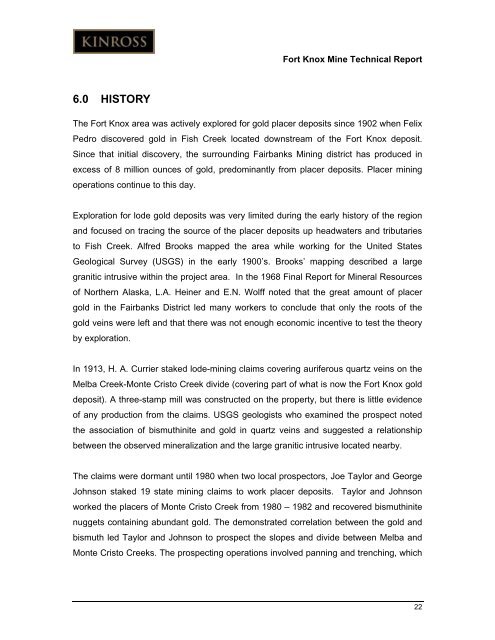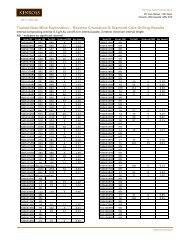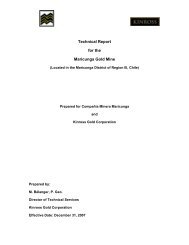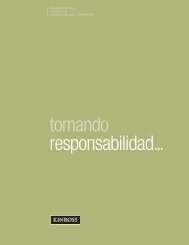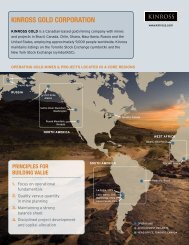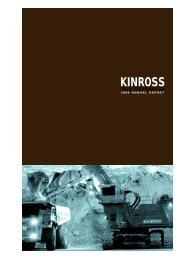Technical Report for the Fort Knox Mine - Kinross Gold
Technical Report for the Fort Knox Mine - Kinross Gold
Technical Report for the Fort Knox Mine - Kinross Gold
You also want an ePaper? Increase the reach of your titles
YUMPU automatically turns print PDFs into web optimized ePapers that Google loves.
<strong>Fort</strong> <strong>Knox</strong> <strong>Mine</strong> <strong>Technical</strong> <strong>Report</strong>6.0 HISTORYThe <strong>Fort</strong> <strong>Knox</strong> area was actively explored <strong>for</strong> gold placer deposits since 1902 when FelixPedro discovered gold in Fish Creek located downstream of <strong>the</strong> <strong>Fort</strong> <strong>Knox</strong> deposit.Since that initial discovery, <strong>the</strong> surrounding Fairbanks Mining district has produced inexcess of 8 million ounces of gold, predominantly from placer deposits. Placer miningoperations continue to this day.Exploration <strong>for</strong> lode gold deposits was very limited during <strong>the</strong> early history of <strong>the</strong> regionand focused on tracing <strong>the</strong> source of <strong>the</strong> placer deposits up headwaters and tributariesto Fish Creek. Alfred Brooks mapped <strong>the</strong> area while working <strong>for</strong> <strong>the</strong> United StatesGeological Survey (USGS) in <strong>the</strong> early 1900’s. Brooks’ mapping described a largegranitic intrusive within <strong>the</strong> project area. In <strong>the</strong> 1968 Final <strong>Report</strong> <strong>for</strong> <strong>Mine</strong>ral Resourcesof Nor<strong>the</strong>rn Alaska, L.A. Heiner and E.N. Wolff noted that <strong>the</strong> great amount of placergold in <strong>the</strong> Fairbanks District led many workers to conclude that only <strong>the</strong> roots of <strong>the</strong>gold veins were left and that <strong>the</strong>re was not enough economic incentive to test <strong>the</strong> <strong>the</strong>oryby exploration.In 1913, H. A. Currier staked lode-mining claims covering auriferous quartz veins on <strong>the</strong>Melba Creek-Monte Cristo Creek divide (covering part of what is now <strong>the</strong> <strong>Fort</strong> <strong>Knox</strong> golddeposit). A three-stamp mill was constructed on <strong>the</strong> property, but <strong>the</strong>re is little evidenceof any production from <strong>the</strong> claims. USGS geologists who examined <strong>the</strong> prospect noted<strong>the</strong> association of bismuthinite and gold in quartz veins and suggested a relationshipbetween <strong>the</strong> observed mineralization and <strong>the</strong> large granitic intrusive located nearby.The claims were dormant until 1980 when two local prospectors, Joe Taylor and GeorgeJohnson staked 19 state mining claims to work placer deposits. Taylor and Johnsonworked <strong>the</strong> placers of Monte Cristo Creek from 1980 – 1982 and recovered bismuthinitenuggets containing abundant gold. The demonstrated correlation between <strong>the</strong> gold andbismuth led Taylor and Johnson to prospect <strong>the</strong> slopes and divide between Melba andMonte Cristo Creeks. The prospecting operations involved panning and trenching, which22


